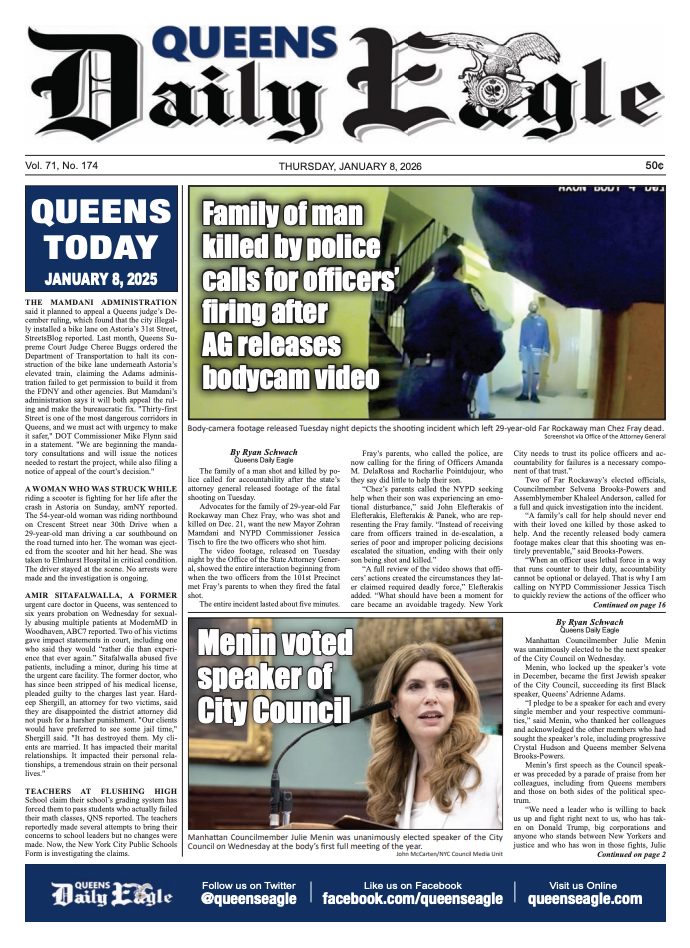Queensbridge residents develop strategies for making a safer community
/NStat members Bob Madison and Gwen Wilson attended Tuesday’s meeting at the Queensbridge Houses. Eagle photos by Jonathan Sperling.
By Jonathan Sperling
The Queensbridge Houses’ Jacob A. Riis Neighborhood Settlement was bustling on Tuesday, as community members, police officers and officials from the Mayor’s Office discussed ending violence at a meeting of The Mayor’s Action Plan for Neighborhood Safety.
The initiative, known as MAP, targets 15 public housing developments citywide in order to promote public safety. Long Island City’s Queensbridge Houses, the largest public housing complex in the Western Hemisphere, is the only MAP site in Queens.
At Queensbridge, a NeighborhoodSTAT team composed of local residents works in tandem with the Mayor’s Office of Criminal Justice to implement tactics for improving community safety. Queensbridge residents are receiving $30,000 in grant money from the Mayor’s Office to produce new safety and security enhancements.
Though MAP was introduced by the city in 2014, the program is primarily driven by Queensbridge residents, said MAP’s Executive Director Renita Francois. Together, these residents form a NeighborhoodSTAT team, which works together with the Mayor’s Office of Criminal Justice to brainstorm how to address community safety.
MAP Executive Director Renita Francois addresses the crowd.
“The purpose of the event is to really involve the people who live in the community in defining safety for the community, and activating them to do something in their own power,” Francois told the Eagle.
Francois said that involvement is “two-pronged” — there are standard sit-down meetings to glean input, but also more interactive methods, such as the ones used during Tuesday’s meeting.
Attendees were encouraged to “experience” the MAP process by reading various poster boards placed throughout the room. These boards detailed the purpose of MAP, the priorities of the NStat team and provided project inspiration based on ideas at other public housing complexes across the city. Other boards invited community members to share where they lived in Queensbridge, and to write down their vision of what makes a safe community.
Queensbridge tenant Gwen Wilson serves as MAP engagement coordinator. Wilson worked tirelessly at Tuesday’s meeting, bustling around the room to speak with residents and her fellow NStat team members before heading to the stage to address the busy crowd.
The latest Queensbridge NStat meeting was interactive.
Wilson told the Eagle that at a previous NStat meeting, attendees decided to expand Queensbridge’s community gardens and translate some of the complex’s welcome signs into different languages.
“We’re hoping by everything that we do, we’ll bring residents together as a community,” Wilson said. “We’re hoping residents will take ownership of where they live, because you know if residents take ownership of where they live, they won’t let certain things happen in their community.
The NStat team also lauded the support of the NYPD throughout the Queensbridge area, prompting applause from residents. NYPD Captain Joe De Leo, who began patrolling Queensbridge around 14 months ago, told the Eagle that he has made it a priority to make officers accessible to the community.
“We just want them [community members] to feel safe and get as much out of their community as possible. They could not be more accepting — I couldn’t ask for a better place to work,” De Leo said.
Bob Madison, another NStat member who serves as the associate executive director at Jacob Riis, stressed the importance of stopping community isolation and beautifying community areas, like gardens.
If we have community members as leaders and caretakers as those particular gardens, and they build their own teams, it will assist in eradicating that community isolation. People now talk to one another, there’s a place to congregate instead of it being a place that is dark and you don’t want to go there,” Madison said.
“These are stepping stones to change what is going on in this community.”






